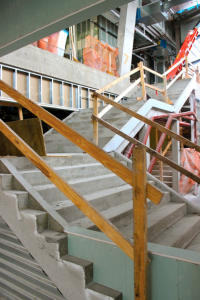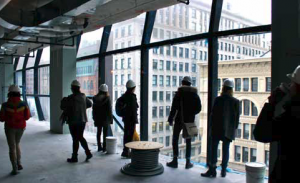Parsons School of Fashion Fully Integrates
Ask any fashionista at Parsons where they study and chances are you’ll hear the term: “Parsons 560.” For years, students, faculty and staff of the acclaimed School of Fashion have used the shorthand to describe their home in Midtown. “Parsons 560” has become a brand: it is the name of the school’s Twitter and Vimeo accounts, as well as its website banner.
Since 1979, the David M. Schwartz Fashion Education Center has brought generations of Parsons students to learn the practice and theory of fashion design in the heart of New York City’s Garment District, two blocks south of Times Square.
The prime location—560 Seventh Ave.—of the School of Fashion at Parsons the New School for Design has spoiled its students with convenience: if anyone ever needed muslin or an extra button, the local stores provided it, all within walking distance.
That ease of proximity to the fashion world is about to come to an abrupt end. On February 22, Parsons Dean Joel Towers announced that in January, 2014, the fashion school will make a big move downtown, joining the cluster of buildings that comprise the university’s main campus.
Five New School buildings will house the Fashion School: the new University Center (still under construction) at 65 Fifth Ave., the Sheila C. Johnson Design Center (located at 66 Fifth Ave. and 2 West 13 St.), 79 Fifth Ave., and the Alvin Johnson/J.M. Kaplan Hall at 66 West 12 St.

In a February 27 email to the fashion school community, Towers wrote, “This move gives us an incredible opportunity to bring our students, faculty and staff together on one campus for the first time.”
The transition downtown is not only an attempt to provide state-of-the-art facilities, but also to encourage cross-disciplinary learning among Parsons students and students from other University divisions.
*****
While students have long complained of the Schwartz Center’s lack of ventilation, poor lighting and decrepit elevators, its value, many said, lays in its location. The Garment District is home to many of the city’s showrooms and some of the most famous fabric stores, such as B&J Fabrics and Elegant Fabrics.
“One of the reasons why I felt like I can still put up with the outdated Schwartz Center was because of the convenient location of the garment district,” said Grace Kim, a sophomore at the School of Fashion. “The location was extremely helpful to my design process because when my professor would say I have the wrong fabrics for a certain season I was designing for, I could go down and quickly match the right fabrics.”
Alexandra Vercruysse, a junior in fashion design with a focus on footwear in the accessories department, said that although the downtown location would be a more convenient commute, she wishes the school could remain in the Garment District.
“I’m working on my junior thesis and you have no idea how many times I’ve had to run out during the day to get more supplies,” said Vercruysse. “Right now we can run across the street, get whatever we need and go back to class.”
*****
Parsons administrators said the decision to move south arose out of a desire to end their isolation from the rest of the university — the initial step in a long-term, far-ranging Master Plan to remake the university’s downtown campus.
In an email to the Free Press, Simon Collins, Dean of Fashion since 2008, wrote, “The decision was made after years of research – interviews and charrettes and workshops and focus groups with hundreds of students, faculty and staff across the university.”
Marble Fairbanks, a Brooklyn-based architecture firm, designed a “master facilities plan” that will serve as blueprint for space allocation in the Parsons transition, as well for the new University Center.
“The fashion move was but one of many broader space-planning strategies on which [Marble Fairbanks] was consulting,” said Collins. “Fashion faculty, as well as many other faculty, were deeply involved in the overall process of making sure that our students have access to the best possible facilities.”
Parsons administrators declined to provide the Free Press with names of any faculty members involved in the consultation process.
In an interview, Towers explained that the School of Fashion’s separation from other departments in the university only made sense due to its convenient location in the Garment District.
“In some ways, the move downtown is something we haven’t been able to support until the University Center opened,” he said. “It’s really part of an overall approach to space and the use of space at the university that’s more intentional.”
In the master plan, Marble Fairbanks not only focused on the amount of space, but also the kind of space that would benefit students. With regard to Parsons studios, for example, Towers explained that given the wide range of student activities, the administration aimed for a collaborative partnership: faculty worked alongside architects to determine how much space was needed and how it should be laid out.
University administrators also spoke of the potential of the new University Center, the first opportunity in decades to cater to specific student needs.
Lia Gartner, Vice President for Design, Construction and Facilities Management at The New School, detailed the new building’s possibilities. “Apart from the 12th Street Lang building,” she said, the University Center is “the first building that was custom-designed for the needs of the school and what is taught.”

Studios in the University Center will include digital projectors for drawing studio classes, tackable wall surfaces, adjustable track lighting and color-rendition lighting for true color. Most classrooms have light shelves located below classroom windows, which reflect light to the ceiling to provide the room with natural light. For the School of Fashion, there will be sewing machines, as well storage spaces in the hallways to hang clothing.
The fate of the Schwartz Center remains unknown. Administrators have recently sent out a request for proposals for a commercial real estate broker. The University is considering either to sell or rent out the building.
“What the ultimate disposition will be, we don’t know,” said New School President David Van Zandt in an interview with the Free Press. “It really depends on what the best deal for us economically would be.”
The name rights of the David M. Schwartz Fashion Education Center will endure. The university will be working with the Schwartz family to identify another space on campus to name in honor of Schwartz, said Deborah Kirschner, associate director of arts communications at The New School.
*****
While the plan drew a mixed response from a number of students, particularly those who found value and convenience in the Schwartz Center’s location, faculty look forward to the proximity provided by the move to the university’s epicenter.
“Our students will still come to the fashion district to shop for their supplies, and in the process they will learn to be organized in planning their shopping lists,” said Francesca Sammaritano, an assistant professor at the School of Fashion.
Other faculty members also see the move as a benefit to the community.
“Our students have always inhabited both campuses, as have many faculty, and starting in January I expect to see a new kind of effectiveness and energy because we will all be working together in close vicinity,” said Timo Rissanen, an assistant professor of fashion design and sustainability. “It seems there will be no limit to the kinds of collaborations that will become possible with being together, that will come out of chance hallway conversations that currently don’t happen.”
Gregory Climer, an assistant professor of fashion design, shared the same sentiment. “Cross pollination with other thinkers and designers [from other departments of The New School] will make us better designers and thinkers,” he said.
Towers, for his part, recognizes that some may not see the beauty of the relocation. Leaving home is “an emotional thing,” he said. But he remains confident that, come January, even the skeptics will be pleased.
“I think,” the Dean said, “pretty quickly people are going to be excited about the new home down here.”








Thanks on your marvelous posting! I genuinely enjoyed reading it,
you might be a great author. I will be sure to bookmark your blog and will
often come back at some point. I want to encourage you
to definitely continue your great job, have a nice day!